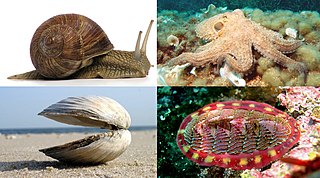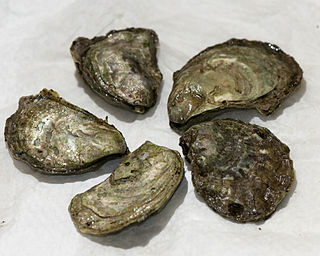
A pearl is a hard, glistening object produced within the soft tissue of a living shelled mollusk or another animal, such as fossil conulariids. Just like the shell of a mollusk, a pearl is composed of calcium carbonate in minute crystalline form, which has deposited in concentric layers. The ideal pearl is perfectly round and smooth, but many other shapes, known as baroque pearls, can occur. The finest quality of natural pearls have been highly valued as gemstones and objects of beauty for many centuries. Because of this, pearl has become a metaphor for something rare, fine, admirable and valuable.

Ammonoids are a group of extinct marine mollusc animals in the subclass Ammonoidea of the class Cephalopoda. These molluscs, commonly referred to as ammonites, are more closely related to living coleoids than they are to shelled nautiloids such as the living Nautilus species. The earliest ammonites appeared during the Devonian, with the last species vanishing during the Cretaceous–Paleogene extinction event.

A seashell or sea shell, also known simply as a shell, is a hard, protective outer layer usually created by an animal or organism that lives in the sea. The shell is part of the body of the animal. Empty seashells are often found washed up on beaches by beachcombers. The shells are empty because the animal has died and the soft parts have decomposed or been eaten by another animal.

Oyster is the common name for a number of different families of salt-water bivalve molluscs that live in marine or brackish habitats. In some species, the valves are highly calcified, and many are somewhat irregular in shape. Many, but not all oysters are in the superfamily Ostreoidea.

Bivalvia, in previous centuries referred to as the Lamellibranchiata and Pelecypoda, is a class of marine and freshwater molluscs that have laterally compressed bodies enclosed by a shell consisting of two hinged parts. As a group, bivalves have no head and they lack some usual molluscan organs, like the radula and the odontophore. The class includes the clams, oysters, cockles, mussels, scallops, and numerous other families that live in saltwater, as well as a number of families that live in freshwater. The majority are filter feeders. The gills have evolved into ctenidia, specialised organs for feeding and breathing. Most bivalves bury themselves in sediment, where they are relatively safe from predation. Others lie on the sea floor or attach themselves to rocks or other hard surfaces. Some bivalves, such as the scallops and file shells, can swim. The shipworms bore into wood, clay, or stone and live inside these substances.

The Western Interior Seaway was a large inland sea that split the continent of North America into two landmasses. The ancient sea, which existed from the early Late Cretaceous to the earliest Paleocene, connected the Gulf of Mexico, through the United States and Canada, to the Arctic Ocean. The two land masses it created were Laramidia to the west and Appalachia to the east. At its largest extent, it was 2,500 feet (760 m) deep, 600 miles (970 km) wide and over 2,000 miles (3,200 km) long.

Archelon is an extinct marine turtle from the Late Cretaceous, and is the largest turtle ever to have been documented, with the biggest specimen measuring 4.6 m (15 ft) from head to tail and 2.2–3.2 t in body mass. It is known only from the Pierre Shale and has one species, A. ischyros. In the past, the genus also contained A. marshii and A. copei, though these have been reassigned to Protostega and Microstega, respectively. The genus was named in 1895 by American paleontologist George Reber Wieland based on a skeleton from South Dakota, who placed it into the extinct family Protostegidae. The leatherback sea turtle was once thought to be its closest living relative, but now, Protostegidae is thought to be a completely separate lineage from any living sea turtle.

Squalicorax, commonly known as the crow shark, is a genus of extinct lamniform shark known to have lived during the Cretaceous period. The genus had a global distribution in the Late Cretaceous epoch. Multiple species within this genus are considered to be wastebasket taxon due to morphological similarities in the teeth.

The giant clams are the members of the clam genus Tridacna that are the largest living bivalve mollusks. There are actually several species of "giant clams" in the genus Tridacna, which are often misidentified for Tridacna gigas, the most commonly intended species referred to as "the giant clam".

The hard clam, also known as the round clam, hard-shellclam, or the quahog, is an edible marine bivalve mollusk that is native to the eastern shores of North America and Central America from Prince Edward Island to the Yucatán Peninsula. It is one of many unrelated edible bivalves that in the United States are frequently referred to simply as clams. Older literature sources may use the systematic name Venus mercenaria; this species is in the family Veneridae, the venus clams.

Protostega is an extinct genus of sea turtle containing a single species, Protostega gigas. Its fossil remains have been found in the Smoky Hill Chalk formation of western Kansas, time-equivalent beds of the Mooreville Chalk Formation of Alabama and Campanian beds of the Rybushka Formation. Fossil specimens of this species were first collected in 1871, and named by Edward Drinker Cope in 1872. With a total length of 3.9 metres (13 ft), it is the second-largest sea turtle that ever lived, second only to the giant Archelon, and one of the three largest turtle of all time along Archelon and Gigantatypus.

Inoceramus is an extinct genus of fossil marine pteriomorphian bivalves that superficially resembled the related winged pearly oysters of the extant genus Pteria. They lived from the Early Jurassic to latest Cretaceous.
Edaphodon was a fish genus of the family Callorhinchidae. As a member of the Chimaeriformes, Edaphodon was a type of rabbitfish, a cartilaginous fish related to sharks and rays. The genus appeared in the Aptian age of the Lower Cretaceous and vanished in the Pliocene. It was most prominent during the Late Cretaceous. Many Edaphodon species were found in the Northern Hemisphere, but species from the Southern Hemisphere are also known.
A valve is each articulating part of the shell of a mollusc or another multi-shelled animal such as brachiopods and some crustaceans. Each part is known as a valve or in the case of chitons, a "plate". Members of two classes of molluscs, the Bivalvia (clams) and the Polyplacophora (chitons), have valves.

A bivalve shell is part of the body, the exoskeleton or shell, of a bivalve mollusk. In life, the shell of this class of mollusks is composed of two hinged parts or valves. Bivalves are very common in essentially all aquatic locales, including saltwater, brackish water, and freshwater. The shells of bivalves commonly wash up on beaches and along the edges of lakes, rivers, and streams. Bivalves by definition possess two shells or valves, a "right valve" and a "left valve", that are joined by a ligament. The two valves usually articulate with one another using structures known as "teeth" which are situated along the hinge line. In many bivalve shells, the two valves are symmetrical along the hinge line—when truly symmetrical, such an animal is said to be equivalved; if the valves vary from each other in size or shape, inequivalved. If symmetrical front-to-back, the valves are said to be equilateral, and are otherwise considered inequilateral.

Ptychodus is a genus of extinct durophagous (shell-crushing) sharks from the Late Cretaceous. Fossils of Ptychodus teeth are found in many Late Cretaceous marine sediments. There are many species among the Ptychodus that have been uncovered on all the continents around the globe. Such species are Ptychodus mortoni, P. decurrens, P. marginalis, P. mammillaris, P. rugosus and P. latissimus to name a few. They died out approximately 85 million years ago. A large number of remains have been found in the former Western Interior Seaway. A 2016 publication found that Ptychodus are likely true sharks belonging to Selachimorpha, rather than hybodonts or batoids as previously thought. Their life history coincides with the typical life of many other large sharks: they lived relatively long lives and were slow growing and produced large offspring and small litters.

Mollusca is the second-largest phylum of invertebrate animals, after the Arthropoda; members are known as molluscs or mollusks. Around 85,000 extant species of molluscs are recognized. The number of fossil species is estimated between 60,000 and 100,000 additional species. The proportion of undescribed species is very high. Many taxa remain poorly studied.

Ostrea lurida, common name the Olympia oyster, after Olympia, Washington in the Puget Sound area, is a species of edible oyster, a marine bivalve mollusk in the family Ostreidae. This species occurs on the northern Pacific coast of North America. Over the years the role of this edible species of oyster has been partly displaced by the cultivation of non-native edible oyster species.

Inoceramus cuvieri is an extinct species of the extinct genus Inoceramus of Bivalve mollusks that serves as an index fossil of chalky rocks of Turonian age of the Cretaceous Period in Europe and North America.

The Kristianstad Basin is a Cretaceous-age structural basin and geological formation in northeastern Skåne, the southernmost province of Sweden. The basin extends from Hanöbukten, a bay in the Baltic Sea, in the east to the town of Hässleholm in the west and ends with the two horsts Linderödsåsen and Nävlingeåsen in the south. The basin's northern boundary is more diffuse and there are several outlying portions of Cretaceous-age sediments. During the Cretaceous, the region was a shallow subtropical to temperate inland sea and archipelago.


















